
Pittosporaceae is a family of flowering plants that consists of 200–240 species of trees, shrubs, and lianas in 9 genera. Habitats range from tropical to temperate climates of the Afrotropical, Indomalayan, Oceanian, and Australasian realms. The type genus is Pittosporum Banks ex Gaertn.

Pittosporum is a genus of about 200 species of flowering plants in the family Pittosporaceae. The genus is probably Gondwanan in origin; its present range extends from Australasia, Oceania, eastern Asia and some parts of Africa. Citriobatus can be included here, but might be a distinct genus. They are commonly known as pittosporums or, more ambiguously, cheesewoods.

Citrus glauca, commonly known as the desert lime, is a thorny shrub or small tree native to Queensland, New South Wales, and South Australia. The 1889 book The Useful Native Plants of Australia records common names native kumquat and desert lemon.

Hymenosporum is a monotypic genus in the family Pittosporaceae. The sole included species is Hymenosporum flavum, commonly known as native frangipani, which is a rainforest tree native to New Guinea, Queensland and New South Wales. Despite its common name, it is not closely related to the frangipani, but is related to the widespread genus Pittosporum.

Bursaria is a genus of eight species of flowering plants in the family Pittosporaceae and is endemic to Australia. They are shrubs or slender trees, often with spiny branches and have simple leaves, relatively small flowers with five sepals, five petals and five stamens, and fruit that is a flattened, thin-walled capsule.

Pittosporum undulatum is a fast-growing tree in the family Pittosporaceae. It is sometimes also known as sweet pittosporum, native daphne, Australian cheesewood, Victorian box or mock orange.
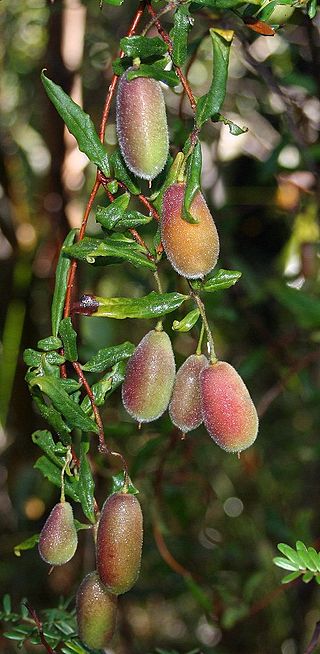
Billardiera, commonly known as appleberries, snot berries, or bluebell creepers, is a genus of flowering plants in the family, Pittosporaceae and is endemic to Australia. Plants in the genus Billardiera are woody scramblers, climbers or twiners with elliptic, lance-shaped or linear leaves arranged alternately along the stems, the flowers with petals that are joined to form a tube at the base with spreading lobes, and succulent or fleshy fruit.

Bursaria spinosa is a small tree or shrub in the family Pittosporaceae. The species occurs mainly in the eastern and southern half of Australia and not in Western Australia or the Northern Territory. Reaching 10 m (35 ft) high, it bears fragrant white flowers at any time of year but particularly in summer. A common understorey shrub of eucalyptus woodland, it colonises disturbed areas and fallow farmland. It is an important food plant for several species of butterflies and moths, particularly those of the genus Paralucia, and native bees.
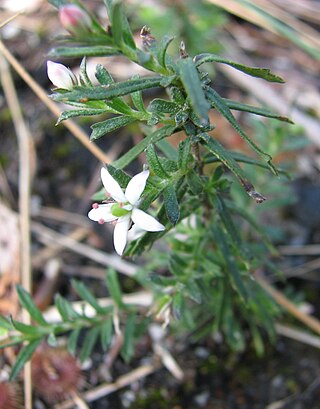
Rhytidosporum is a genus of flowering plants within the family Pittosporaceae. The type species is Rhytidosporum procumbens (Hook.) F.Muell.

Auranticarpa rhombifolia is a rainforest tree of eastern Australia. Known as the diamond leaf pittosporum, this tree is planted in many parts of Australia as an ornamental. The white flowers and orange fruit make it a most appealing street or garden tree. Other common names include hollywood, diamond leaf laurel, white myrtle and white holly.
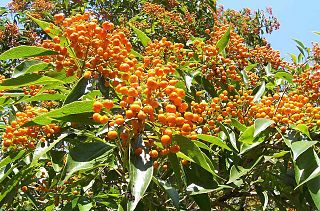
Auranticarpa is a genus of trees in the family Pittosporaceae. All six species occur in monsoonal forest and rainforest margins in Northern Australia. The species, all formerly included in the genus Pittosporum, are as follows:

Coprosma quadrifida is a dioecious shrub of the family Rubiaceae native to southeastern Australia. First described as Canthium quadrifidum by Labillardiere, it was given its current name by B. L. Robinson in 1910. Typically found at damp sites within woodlands, Eucalyptus forests or cool-temperate rainforests, it prefers sheltered slopes or sites near water sources. They are able to withstand frost and are salt tolerant. The species is also known as the Prickly Currant Bush.

Billardiera heterophylla is a species of flowering plant in the family Pittosporaceae, known by the common name bluebell creeper. It is native to Western Australia, but is grown as an ornamental plant in appropriate climates worldwide. It can sometimes be found growing in the wild as an introduced species or garden escapee, for example in other Australian states and in California, where it is popular in landscaping. It is sometimes considered a weed.

Pittosporum spinescens is a shrub native to woodlands and dry rainforest of Northern and Eastern Australia and New Guinea. Growing to 7m tall with small leaves clustered on short branches that often terminate in a sharp point. The plant produced edible fruits, 2–3 cm in diameter. It is commonly known as wallaby apple, orange thorn or thorn orange. P. spinescens is very similar in appearance to the closely related Pittosporum multiflorum, but is readily distinguished by its entire leaf margins, in contrast to the toothed leaf margins of the latter.
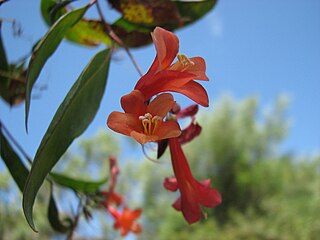
Marianthus is a genus of flowering plants in the family Pittosporaceae and is endemic to Australia. Plants in the genus Marianthus are shrubs with twining branches, simple leaves arranged alternately along the stems. The flowers are pendent, arranged singly or in small groups in upper leaf axils or on the ends of branches with small bracts and bracteoles at the base, but that fall as the flowers open. The sepals are free from each other, and the petals are also sometimes free from each, otherwise joined at the base, forming a tube with spreading lobes. Plants in this genus were previously included in Billardiera, but have a stalked ovary and a long, usually curved style. The fruit is a dehiscent capsule containing many seeds.

Pittosporum angustifolium is a shrub or small tree growing throughout inland Australia. Common names include weeping pittosporum, butterbush, cattle bush, native apricot, apricot tree, gumbi gumbi, cumby cumby, meemeei, poison berry bush, and berrigan.
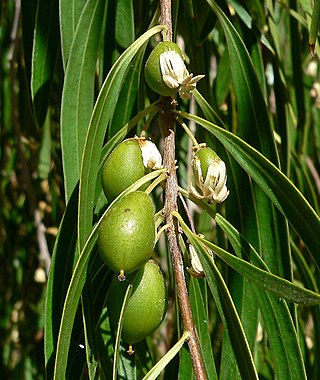
Pittosporum phillyreoides, with the common names weeping pittosporum and willow pittosporum, is a shrub or small columnar tree in the Apiales order, endemic to Australia.
Rhytidosporum inconspicuum is an inconspicuous, rhizomatous shrub in the pittosporum family, Pittosporaceae. The species is found in New South Wales, Victoria and Tasmania.

Pittosporum ferrugineum, commonly known as the rusty pittosporum or rusty-leaved pittosporum, is an evergreen plant in the family Pittosporaceae native to Malesia, Papuasia, the Northern Territory and Queensland.



















